INTRODUCTION
The worship of goddess Durgā or Durgāpūjā among the Bengalis presents and represents culture, commodity and identity and brings to the fore many more things or issues that have implications not only for a people but also for broader anthropological studies of people and culture linking global to the local. The worship (pūjā) of the goddess is held four days in the Bengali month of Aswin (usually coinciding with October in English calendar). The Durgāpūjā is considered as the annual festival of the Bengali people living mainly in the states of West Bengal and Tripura in India and Bangladesh with speakers numbering around 200 million. It is the largest popular public socio-religious event in Bengal. It has almost become a feature of Bengali national culture to organize the Durgāpūja is an important event in diaspora. Though predominantly originated in the Hindu ritual and legends, the Durgāpūjā celebration cross cuts the communal divide in many of its attributes. It has been projected so in the public to be an epitome of harmony across caste, class, creed and religion by constantly emphasizing its secular aspects.
As the worship has such a deep and pervasive influence on the life and culture of the people in Bengal, it has been a subject of wide attention from scholars belonging to various disciplines and theoretical schools. Various scholars have discussed the origin of the goddess and its iconographic representations, its growth and the spread of the worship from the houses of rich zamindars and elites to the public arena as bāroẏāri celebration. They have also dealt with the other aspects of Durga Puja, such as the organization of pūjā, its relation with Bengali identity etc. Ghosh1 has found the association between pūjā and power in his richly documented article. The ethno-historical aspects of the politico-ritual life of South Odissan kingdom as reflected from the worship of Durgā by the king have been studied by Schnepel2 That this pūjā has contributed to the new forms of mytholozization was brought out by Ghosh3 in her essay that reflects another contemporary thought on the Durgāpūjā. Bandyopadhyay4 has pointed to the cultural industry5 that emerged through multiple cultural productions and re-invention of folk life during Durgāpūjā celebrations. The celebrations of folk items has been the staple of many discussions on the Durgāpūjā in contemporary times.6,7,8,9
Ákos Östör,10 a great scholar of Hindu rituals and practices conducted a detailed study of the Durgāpūjā from a symbolic anthropological perspective. His study articulates a pithy analysis of the social structure, human dispositions, spatio-temporal dimensions, rules of conduct and concomitant elements loaded with symbolic meaning. Narrating the entire ritual cycle of the worship spanning for 4 days and uniting the ritual events and behaviors in a thread to relate them with the divisions of time, space and cosmology, he has come to make sense of this ‘very complex divinity’ (p.88) in Bengali culture. This highly nuanced festivity did not escape the experienced gaze of anthropologist Ralph Nicholas.11 What Nicholas11 surmised in his objectives of study tells a lot about the meaning Durgāpūjā has for the Bengalis. He wrote (p.3): “The present work is an effort to interpret the rural form of the pūjā, itself transformed by the changes of modern India, as it was seen in the village in 1970. There are several features of the ritual as described here to which I pay particular attention. (1) Durgāpūjā is only the beginning of a sequence of worship that extends through the following weeks, during the period when the gods are supposed to be sleeping. (2) The curious idea that Durgā must be awakened for worship is examined for what it says about the religious history of Bengal. (3) The structure of rural society that was enacted in the autumnal sequence of rites in 1970 was a pale reflection of the old order, which I call sacrificial polity, but it was significant as an indication of what Durgāpūjā once meant in sociological terms. In the year since 1970, the social significance of the pūjā has moved ever further from the representation of hierarchy and towards the ever present theme of family reunion. (4) Although the social order of caste-based dominance and sub-ordination is dissipating, the preservation of the tradition of the family or “house” remains a central value; it ties modern, urban Bengalis to their ancestral village homes. (5) Compared to urban, collectively organized Durgā pūjās, the village pūjās are very attentive to the correct performance of the ritual; and they continue to include the prescribed animal sacrifices as the foremost offering to the goddess.”
The above characterization by Nicholas no doubt brings to the fore almost all the essential features of Durgāpūjā in Bengal, however some changes have already been there particularly with reference to sacrificing and eroding ritual sanctity even in rural Bengal too. But the theoretical hook that he brought to pin his thought was the symbolic implication the worship and celebration manifests. It is that the ‘hierarchy is ritually enacted and the authority of the magnate is legitimized’ in Durgāpūjā. Thus, the important consideration is the power, identity, authority and their relation with the social structure and belief.
Another fervent discussion on Durgāpūjā involves the changing facets of the festivity in the recent years. In this regard the scholars have moved from mundane description of the changes to the analyses of changes at the meta-theoretical level.3,9,12,13 It is written that: ‘Durgā is no longer a part of the stream of Bengali life, no longer identified with the land of Bengal conceived as mother, she is an intrusion, almost imported, never happy in anything except nylon’.12 Again Ghosh3 writes, “The city-scapes acquires a new dimension which is illusive and real at the same time, ‘A post-modern exhibition’ that pays no heed to time, place, country and culture.”
Against this backdrop of plethora of historical and ethnographic studies on Durgāpūjā, I would like to make some points as an insider as well as a participant observer who has formal anthropological training and a battery of research tools with which I would aspire to be theoretically reflexive. Initially I would deal upon the materiality that surrounds the rituals and celebration in the very recent years and the ingrained ethos with which the Bengali people structure their lives on Durgāpūjā. Then I pass on to the discussion why the Durgāpūjā has come to be the most important celebration for the Bengalis. Here, I have interrogated some earlier explanations and tried to substantiate the interpretation by positing my argument against the Hindu principles of life that the worship putatively foregrounds.
DURGĀ: IMAGE, WORSHIP AND CELEBRATION
The traditional image of Durgā depicts an ensemble of the goddess and her 2 daughters-Lakshmi and Saraswati and 2 sonsGanesh and Kartick-with the husband Siva’s face overlooking them atop held in a single background scaffolding (cālcitra) (Figure 1). Here the large idol of Durgā, slaying the buffalodemon Mahiṣāsura, is seated on a lion with her 10 arms holding weapons respectively gifted to her by the gods. All these weapons have symbolic meaning. But this single-cālcitra or ekcālā image (mūrtiorpratimā) is replaced everywhere with the one in which the idols are separately placed at the altar with the goddess Laxmi and Ganesh in the right and Saraswati and Kartick on the left, except some of the more traditional public and household worships (Figure 2).
Figure 1: A Traditional Durga Idol in Ekchala ( Single Background) Arrangement, here Goddess is also Shown with her Children Laxmi and Ganesh in the Right and Saraswati and Katick in the Left.
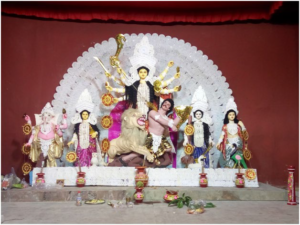
Figure 2: A Traditional Durga Idol, here Goddess is Shown with her Children Laxmi and Ganesh in the Right and Saraswati and Katick in the Left.
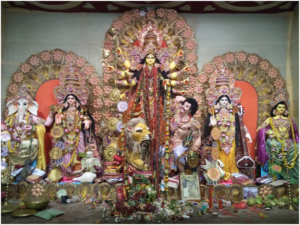
The idols are made of straw and clay. On the bamboo frame a structure of idol is made of straw on which layers of clay is plastered and smoothened to give the final form. Face, fingers and some other parts of the body are made in mold. After painting and drawing of eyes, the idol is decorated with appropriate clothing and ornaments made of sola pith or imitation jewelry. It has been a great sight to see this idol making by expert potters (kumor) in their studios (golā) generally located in fixed enclave called Kumorpārā. Much before the pūjā the preparations start. The organizers begin to pour in these studios and make an advance payment (bāẏnā) for their idols. Sometimes they ask for a stylistic change for their idol and instruct the potter to make an idol in a special form (ārterṭhākur). Now these innovative forms of idol have become a fashion of the day and many of organizers are famous for new inventions each year. One extreme example of such exhibition was the “world’s largest idol of Durgā” in Deshapriya Park, Kolkata in 2015. In 2016, there was a thousand-arm image of Durgā, which the organizer is advertised through large flex banners displayed across Kolkata (Figure 3). It was so huge and attracted so many visitors that an accident happened, forcing the police to close the worship for that year. The advertisements for this idol were displayed across the length and breadth of the country, spanning hundreds of kilometers in stretch.
Figure 3: A Thousand-Arm Durga Idol, an Example of Recent trend of Arter Thakur
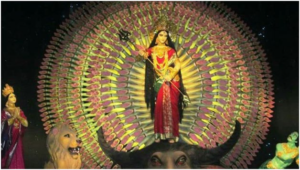
Apart from idol, the pyāndel or the large scaffolding attracts thousands of visitors for the lure of ‘theme’ that they organizers would like to exhibit. These ‘themes’ may express some abstract idea having social or environmental concern both at local as well as global level or these may simulate a famous architecture that the artists and pyāndel makers would emulate here with perishable materials. For all the crowd-pulling pujas, ‘theme’ of the pyāndel remains the main attraction, which is more fashionable and adds prestige to the organizers. In fact, we notice a simulacra in this puja pyāndel in the Baudrillardian sense.14 Much before the actual pūjā, pyāndel makers start their work. They create large buildings or temples or palaces mainly out of perishable materials. These are not real but carries the sense of hyper real. Baudrillard wrote that contemporary cultural productions are itself hyperreal. These structures often bring before us a world that is not an actual replica of some real thing, but the perfect depiction of the order of reality. This type of creations bear the features of simulation of which Baudrillard writes that ‘it is the generation by models of a real without origin or reality: a hyperreal’ (Figure 4).15
Figure 4: Huge and Colorful Pyāndels (Makeshift Structure Where Goddess is kept ) are Sites of Attraction in Durgā Pūjā. The Folkart of Serpai is used in the Above Pyāndel of Goddess Durgā in Kolkata.
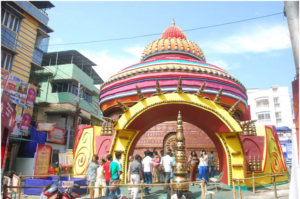
However, the idol of Durgā with her family was not the original form in which the goddess is being worshipped for millennium in the Indian subcontinent and central Asia.16,17 The Mahiṣāsuramardinī (goddess slaying the buffalo demon) is the pristine form. The worship of entire family of the goddess was started during the medieval period in Bengal. There were contesting demands for who started the worship first in Bengal. It was obviously the wealthy zamindars, locally known as rājā who used to organize such grand celebration in his house. Some wealthy merchants also began holding Durgāpūjā in their family. It attracted a huge gathering of people from the surrounding. These people, belonging to different caste and class had different role to perform in the pūjā when they were tied in jajmani relationship. In jajmani relationship the castes were tied up in a network service and counter –service to each other. Each of them was jajman to each other. For example the Brahmin used to provide ritual service to say the agriculturist castes and service castes like barber, in return these castes would give food grains or do regular shaving of the Brahmins. These castes used to play particular role at the time of Durga puja. However this village network based worship organized by big landlords was soon replaced by a collective worship by the commons in the form of bāroẏāripūjā which is claimed to have started in 1790 at Guptipara in Hooghly district.18 Now the goddess came out of the precincts of her palatial shrine of big houses to the make-shift pyāndel in some open common space in the locality under the aegis of a club or organizing committee.19 The organizers collect subscription (c̐ādā) from the individual families in the area and depend on advertisers for organizing such a grand event. Nowadays, multinationals and big companies come forward as sponsors as the festival brings before them a great occasions to showcase their public visibility. Some of the pūjās are occasion for the political leaders to exhibit their power and influence This is now a well-established practice in many parts of the state.1,20,21
The Durgāpuja is also called śārodīẏāuṯsab (autumnal festival). The worship is held for four days, coined after the tithi (day as per lunar calendar). These are Shashṭhi (1st day of worship), Saptami (2nd day), Ashtamī (3rd day) and Nabamī (4th day). Eating various foods and preparing delicacies at home are also quite enjoyable. Four days of pyāndel hopping adds special thrill to the celebration. This time cities remain awake day and night. Roads are decorated with colorful lights and gates. Songs are aired in amplifiers in the pyāndels. There is much fun, amusement and spirit of carnival. This light and sound in the public spaces around the pyāndel reflects that we like a discothèque kind of enjoyment. After Nabami, comes the day of Bijaya Dashami (day of immersion). It’s a very emotional day for the Bengalis. Bengalis exchange kolākuli (hugging) with friends, convey respect (pranām) to elders and receive blessings (Aśīrbād) in return. The puja started with a prayer that may the goddess wipe out all the durgati or sufferings (Durgādurgatinashini). On the day of Bijaya, the Bengalis pray to the goddess to come back next year (punarāgamanāẏaca).
Durgāpūjā is the occasion for multiple functions, preparations, exposition and references in Bengali life. In quotidian conversations particularly during pre-puja months , people used to refer to puja time as temporal marker. For example, if you ask one person. The annual calendar is structured to accommodate the cycles of events that precede the celebration and follow it. The roads get queued with panels of advertisements and banners, and potholes are mended through patchworks. The newspapers throng with news of pūjā preparations at different places and stories on the theme. With passing of each day, the TV channels start countdown that shows how many days are left for the pūjā. Various business houses announce prizes in different categories that range from idol, pandel, lighting etc. to environmental awareness of the concerned pūjā committee. The literary magazines bring out their special pūjā number. Pūjā songs are especially composed for the occasion by the renowned singers. The fashion designers also eye on Durgāpūjā to launch their new designs. In fact the pūjā shopping is a huge craze among the Bengalis. We do not buy for us only, but also for the near and dear ones. The big and small companies announce special pūjā offers keeping in view the buying spree of the people during this time. The government and private offices give bonus to their employees. The longest holiday at a stretch is also to be enjoyed in pūjā. Many of us, plan tours for this holiday and hotel bookings and purchase of train tickets have to be completed months before. In fact the Indian Railways schedule extra trains to meet the rush of passengers for this festival. Many of our references of events that we want to do get tucked with pūjā time. As the pūjā approaches near, we begin to slip into a holiday mood. Earlier we used to enjoy a month long holiday during pūjā in schools and colleges, however now the duration of holiday has decreased. Still it is a fact that different people in their respective vocations gear up their business accordingly to avail themselves of the opportunities the pūjā opens up for them. Again the administration remains very alert to avoid any untoward incidences. Therefore the Durgāpūjā necessitates all sorts of preparations in a very circumscribing manner so as to include social, religious, aesthetic, economic and political spheres of life. The Bengali Hindu people pass through a social liminality22 in the cycle of collective existence of their life. During the period of Durga puja, the normal activities in all the above mentioned spheres are either suspended or expanded or continue at a different pace. Since this condition affects the entire Bengali society, the Bengali people seem to be in a liminal state which appears to me a kind of totalizing experience in life in Bengal.
DURGĀPŪJĀ: TOTAL PRESTATION
While translating Mauss’ classic The Gift into English, both the editor and the translator were not sure about the actual meaning of the word ‘total prestation’ since there was no English synonym for it. Thus they tried to understand its meaning from the contextual use and accordingly it has been called either “total services” or “free or obligatory exchanges of material or nonmaterial things.” Mauss23 wrote (p.3), “For it is groups, and not individuals, which carry on exchange, make contracts, and are bound by obligations; the persons represented in the contracts are moral persons-clans, tribes, and families; the groups, or the chiefs as intermediaries for the groups, confront and oppose each other. Further, what they exchange is not exclusively goods and wealth, real and personal property, and things of economic value. They exchange rather courtesies, entertainments, ritual, military assistance, women, children, dances, and feasts; and fairs in which the market is but one element and the circulation of wealth but one part of a wide and enduring contract.”
In the introduction to Cohen and West edition to the book, Evans-Pritchard wrote24 (p.7), “‘Total’ is the key word of the essay. The exchanges of archaic societies which he examines are total social movements or activities. They are at the same time economic, juridical, moral, aesthetic, religious, mythological, and socio-morphological phenomena. Their meaning can only be grasped if they are viewed in as a complex reality” (Figure 5).
Figure 5: A Priest is Offering the Gourd before Sacrifice in front of Goddess Durga.( Photo Courtsey: Anirban Adhikary).
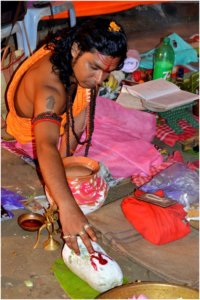
Mary Douglas, in her introduction to the Rutledge edition of this book has also pointed to the totalizing character of such an event called total prestation.25,26 Now if we look at the Durgāpūjā of the Bengali people we find that it encompasses almost every sphere of Bengali life and presents the occasion to obligatory discharge some of our solidarity engagements. This is manifest in the giving and receiving gifts and counter-gifts between consanguineal and affinal relatives. This network of obligatory payments was more evident in the jajmani system where the jajmans used to receive their annual payments for the goods and services they have been giving in exchange. Now exactly this system may not be followed in most of the cases as the traditional jajmani obligations have gone, but the solidarity obligations are still working in different forms. The engagements of different castes and classes of people have still remained unchanged in ritual. In fact, it is more extensive now with the inclusion of many of the secular events in the celebration. The people contribute subscription (c̐ādā) to the collective fund under the disposal of the organizing committee. Each according to his/her capacity is expected to contribute. This payment is morally more obligatory than in physical sense.
Not only in archaic society there is need for some or at least one occasion that would offer the members of the society or community the opportunity to unite and to show solidarity as a single bounded moral community. It is essential for the existence or survival of the particular community. Durgāpūjā brings before us that opportune moment to express our solidarity as Bengali. This is one of the most important reasons why Durgāpūjā is so important for the Bengali Hindu people. But it does not give the answer why has it become so important.
HOW DURGĀPŪJĀ HAS BECOME SO IMPORTANT
Almost all the scholars who have worked on the goddess Durgā, have conceded that the deity is a highly complex phenomenon. In the previous section we have seen that Durgāpūjā performs a very pivotal role in the life of the Bengali people. Rodrigues27 mentioned about four important functions of the Durgāpūjā. These are: (i) Cosmic rejuvenation; (ii) Empowerment at personal, sovereign, communal, political and economic levels; (iii) Fertility; and (iv) Religious functions. McDermott28 identified a strong nexus between the religious and economic interests. She has presented the contested viewpoints explaining the rise of the Durgāpūjā in Bengal. She concluded that both the view points are inherently biased. But the main factors that emerged from her deliberation to be instrumental behind the rise of worship were the exercise of political control and expression social prestige. Its growth has also been attributed to the emergence of new sites of public sphere in neo-liberal economic conditions.29
The timing of the worship if set against the agricultural calendar, would appear to be much suitable as there is little pressure of agricultural work during this period. The weather is also very comfortable. Another, point that is often referred by some elderly people that the number of puja is increasing day by day however the religious devotion is decreasing. They attribute this to the increasing unemployment of the youth, which according to them has a substantial role in the growth of puja. Thus, the economy seems to play an important role in this manner in the recent rise of Durga worship.
In this context, my argument is very simple. I would like to add that the semiotic association between the conceptualization of the goddess and the traditional Indian cosmological, philosophical and behavioral categories.
Cosmology reflects a sense of unified reality in which the ‘social relations, political conventions as well as beliefs about gods and supernatural powers all become the part of the body of conceptions that enumerate and classify the phenomena constituting the universe as ordered whole’ and the norms and processes which govern this order of existence.30,31,32 It is also a body of living tradition of knowledge as Fredrik Barth opines.33 The Durgāpūjā is organized at a community level (bāroẏārī), When it is held at the houses of elite class of people (banedībāŗi), it also carries the collective spirit through the involvement of the entire family(paribār) or the lineage (baṃśa). In the worship, different castes and classes of people have respective roles. The prostitutes who are generally regarded as outcaste and looked down up on in the society are not left totally an outsider; soil from the entrance of her house is required in Durgāpūjā. In traditional society, the untouchable castes like Dom who are drummers, potters, weavers, barbers, have considerable professional engagement. In contemporary society, this involvement of the various cross-sections of the society as stated above is also manifest. The political conventions also classify this space as a site of power. As if, the cosmic power of the omnipotent goddess is now paralleled with the mundane political solipsism that represents a sense of supreme power without the sanction of which nothing can be done in this material world. The present political culture in the state has a totalitarian intervention in the every sphere of life. It derives its power from the collectivity. The groups of worshipper under the patronage of such power can bend laws or defy it. Therefore, it possesses a power above the individual level to heightened level of existence where the normal order often gets suspended. Durgāpūjā is the occasion which provides us the opportunity to know our potential as a collective force and it lends us a sense that as a collective we are enormously powerful. It is both an enjoyable and a pleasurable feeling. Our philosophy deals with matters far above this mundane level of experience and perception, and may lend us the clue to this ideological or cognitive background. We nourish a ideology which may appear to the western understanding as a kind of undermining of human agency in understanding the religious beliefs and practices. Here, individual is considered an extension of the collective and vice-versa. It is well understood in the aphorism: Yathā Brabhānḍe Tathā Pinḍe (whatever is in macrocosm that is in microcosm). This is probably the most important reason why Indian as well as Bengali culture so beautifully accommodated the plurality. Devisukta (Rg. Veda, 10 Mandala) that reveals the goddess before us and it is the ritually prescribed incantation before actual reading of the Chandi at the time of Durgāpūjā throws some light on this individual-collective relationship. Here 1st of the 8 slokas (stanza) of the Devisukta states that the goddess is Rudra, Basu, Aditya, Mitra, Baruna,, Indra, Agni, and Aswini kumar doy personified in one body. All these divine forms are contained in her. Again in the Chandi, She is telling: Ekoibāhaṃ Jagatyatra Dvitīẏā Kā Mamāparā (‘I am the only one that exists in this universe, there is no second’). It has a mythical root in the story of destruction of demon (Asur) Sumbha. Sumbha found Durga in the battlefield with all the goddesses in arms. Then Sumbha chided the goddess that she is fighting with the help of these goddesses. Then, goddess Durga uttered words mentioned above. She assured the demon king that all these forces are her energies and showed him how these goddesses would merge into her body instantaneously.34 The revelation of Viswarupa (universal form) to Arjun by the Sri Krishna in The Geeta bears another instance how Hindu thought symbolized the plural in singular, many in one.35 Troy Wilson Organ writes that ‘the goal of Hinduism is not that all men become Brahman, not that all men be liberated from the wheel of Sansara; it is that the promises inherent in men be actualized, that this universe be harmonized, that all human faculties be unfolded and liberated in an active, creative life of the spirit’.36 Stephen Tyler has also talked about the social order in relation to the macrocosm in which the individual experience takes shape in Indian culture.37 Dumont dealt with this question of relation between individual and collective in Indian thought with the special reference to socio-religious domain.38 He was of the opinion that the normative individual of western perception is absent here. The exploration of Indian categories in understanding the cultural ethos and its relation with the underlying philosophy has laid to a better identification of the preeminent symbols.39,40,41,42 In fact, traditional Indian social structure and contemporary behavioral practice bring to the fore the emphasis on the collective over individual. The Varna system specifies the order for the group not for the individual. This hierarchic structure later transmuted into hereditary caste based occupational groups where the knowledge and skill of the members of the specific caste would remain sacred for the insiders, this would go down up to family level.43 In the traditional agrarian and artisanal modes of production, the family was the unit. Our use of kin terms as suffix or sometimes independently to address completely non-kin individual in the society (say the shopper, vegetable sellers, fish seller, other people whom we meet in our quotidian life) shows that we consider ourselves to have enmeshed in kinship ties. This familiar form of address is a good case of our unconscious semeiotic grammar of cosmological and philosophical cognition that has finer ramification at the higher perceptual level. This semiotic association of cosmological, philosophical and behavioral practices finds another expression in the celebration of collective in Durgāpuja.
It is said that ‘man in Indian cultural tradition is conceived as a ‘cosmo-centric’ being i.e., ‘a trans-social being’ or transcendental ‘self’ and not merely a bio-social animal…’.30 Here exists a ‘dialectic world of negation (nivritti) and world-affirmation (pravritti).The conception of Siva and Durgā presents that dialectic. It upholds the destruction evil as Durgā slays buffalo demon Mahishasura who again is worshipped at the same time. Again dialectics of binary nature present in Hindu socioreligious life as mentioned by Madan44 are well epitomized in the goddess. The ambivalence in the imagination of the idol has also been noticed by Nicholas.45 Again Kashyap30 has remarked that the Hindu culture is aesthetically oriented mythic culture, the Durgāpūjā contextualizes probably the greatest public and popular aesthetic expressions of Bengali culture. The Indian ideal of culture traditionally emphasizes the ‘collective’ over the individual. An individual is seen in the socio-religious context in which he or she belongs. The Durgā’s arrival with her family embodies the family ethos in Bengali culture. One may find echoes of Durkheim’s understanding of religion.46 But, it is obvious that the sense of collective provided the foundational backup in which the Durgāpūjā thrived.










